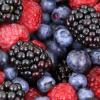Round Two
I figured that Jiaogulan couldn't be the only supplement shown to have regenerative properties for the dopaminergic system, so I did some digging and found some dirt. 6 new neuroregenerators, 2 very promising, 2 promising, and 2 duds (listed in that order). I've also included 2 other dopaminergics, one is a promising SNDRI with lots of traditional human use but seriously lacking in scientific trials, the other is essentially completely unstudied all-around, making for a total of 8 new dopaminergics.
Stereospermum suaveolens - An incredibly understudied medicinal tree used in Ayurveda with all parts containing medicinal properties. Had by far the most significant regenerative effects to the dopaminergic system out of all these second round supplements, giving Jiaogulan a run for its money, although the dose may be a bit impractical (unlike Jiaogulan). Has understudied neuroregnerative [
1], neuroprotective [
2], hepatoprotective [
3], gastroprotective [
4], antihyperglycemic [
5], antioxidant [
5], antipyretic [
6], anti-inflammitory [
7], and analgesic [
6] properties. Seems to also offer
some pretty significant stimulatory effects that doesn't seem to have standard tolerance issues (see data from study below), since by day 30 most of the rats treated with the medium to high doses of
S. suaveolens were more active than the sham group, and this level of activity continued to increase all the way to the end of the study at 42 days. Very interesting plant to say the least.
Objectives: To evaluate the neuroprotective effect of Stereospermum suaveolens DC on 6-hydroxy dopamine induced Parkinson's disease model.
Materials and Methods: The study was conducted on Sprague-Dawley rats where parkinson's disease was induced by producing the striatal 6-hydroxy dopamine lesions. The test animals received methanolic extract of Stereospermum suaveolens at dose of 125, 250 and 500 mg/kg for 42 days. Behavioral assessment, spontaneous locomotor activity and muscular coordination were studied. Antioxidant levels, striatal infraction area were assessed and histopathological studies were carried out.
Results: The Stereospermum suaveolens DC methanolic extract showed significant dose dependent increase in behavioral activity, improved muscular coordination. Significant reduction of lipid peroxidation (LPO), increased antioxidant enzymes like superoxide dismutase (SOD), catalase (CAT) and non-enzymatic activity of glutathione (GSH) and total thiol levels in extract treated groups was observed in test groups as compared to control group. Striatal infarction area was significantly reduced in extract treated groups as compared to control group.
Conclusion: The methanolic extract of Stereospermum suaveolens DC showed neuroprotective activity against 6-hydroxy dopamine induced Parkinson's disease in rats.
http://www.ncbi.nlm....les/PMC3523502/Uncaria rhynchophylla - Another plant used in Ayurveda that has shown neuroregnerative properties specifically for the dopaminergic system at
very relevant oral doses.
Seems to require the lowest dosage out of all supplements to achieve neuroregenerative effects and less seems to be more with this extract as a high dose showed less benefit than a low dose, unlike Jiaogulan or S suaveolens, both of which seem to have dose dependent effects. In-optimal dosing was used for testing, needs more scrupulous testing. Less impressive neuroregeneration than
S. suaveolens or Jiaogulan, but still very promising.
While the hook of Uncaria rhynchophylla (URH) is a traditional herb used in northeast Asia for the treatment of Parkinson's disease (PD)-like symptoms such as tremor, it has not been experimentally evaluated in a PD model... We investigated the effects of URH on 6-hydroxydapamine (6-OHDA)-induced neurotoxicity in in vitro and in vivo models of PD. The cell viability, anti-oxidative activity, and anti-apoptotic activity of a water extract of URH (URE) were assessed using 3-(4,5-dimethylthiazol-2-yl)-2,5-diphenyl-tetrazolium bromide, reactive oxygen species (ROS), total glutathione (GSH), and caspase-3 assays in PC12 cells stressed by 6-OHDA. We also investigated the behavioral recovery and dopaminergic neuron protection of URE using an apomorphine-induced rotation test and tyrosine hydroxylase immunohistochemistry in the hemi-parkinsonian rat model of the unilateral 6-OHDA lesion of the medial forebrain bundle... In PC12 cells, URE significantly reduced cell death and the generation of ROS, increased GSH levels, and inhibited caspase-3 activity induced by 6-OHDA. In 6-OHDA-lesioned rats, posttreatment with URE (5 mg/kg/day for 14 days) significantly reduced apomorphine-induced rotation, and it lowered dopaminergic neuronal loss in substantia nigra pars compacta... URE possesses neuroprotective activity against 6-OHDA-induced toxicity through anti-oxidative and anti-apoptotic activities in PD models
http://www.sciencedi...378874109005224Black tea - Unknown whether or not green tea has the same effects, but
at least one epidemiological study suggests that the effects are solely with black tea. Dose may be too high to be relevant, but epidemiological data suggests otherwise.
In the present study, an attempt has been made to explore the neuroprotective and neuroreparative (neurorescue) effect of black tea extract (BTE) in 6-hydroxydopamine (6-OHDA)-lesioned rat model of Parkinson's disease (PD). In the neuroprotective (BTE + 6-OHDA) and neurorescue (6-OHDA + BTE) experiments, the rats were given 1.5% BTE orally prior to and after intrastriatal 6-OHDA lesion respectively. A significant recovery in d-amphetamine induced circling behavior (stereotypy), spontaneous locomotor activity, dopamine (DA)-D2 receptor binding, striatal DA and 3–4 dihydroxy phenyl acetic acid (DOPAC) level, nigral glutathione level, lipid peroxidation, striatal superoxide dismutase and catalase activity, antiapoptotic and proapoptotic protein level was evident in BTE + 6-OHDA and 6-OHDA + BTE groups, as compared to lesioned animals. BTE treatment, either before or after 6-OHDA administration protected the dopaminergic neurons, as evident by significantly higher number of surviving tyrosine hydroxylase immunoreactive (TH-ir) neurons, increased TH protein level and TH mRNA expression in substantia nigra. However, the degree of improvement in motor and neurochemical deficits was more prominent in rats receiving BTE before 6-OHDA. Results suggest that BTE exerts both neuroprotective and neurorescue effects against 6-OHDA-induced degeneration of the nigrostriatal dopaminergic system, suggesting that possibly daily intake of BTE may slow down the PD progression as well as delay the onset of neurodegenerative processes in PD.
http://www.sciencedi...969996105003384Oxyresveratrol - Found in mulberries, oxyresveratrol seems to have more promise than resveratrol r.e. neuroregeneration.
In vitro evidence only, while all other previous supplements have had
in vivo evidence to support dopaminergic restoration. Relevant dose unknown.
Oxyresveratrol (OXY) is a polyhydroxylated stilbene existing in mulberry. Increasing lines of evidence have shown its neuroprotective effects against Alzheimer disease and stroke. However, little is known about its neuroprotective effect in Parkinson disease (PD). Owing to its antioxidant activity, blood-brain barrier permeativity, and water solubility, we hypothesized that OXY may exert neuroprotective effects against parkinsonian mimetic 6-hydroxydopamine (6-OHDA) neurotoxicity. Neuroblastoma SH-SY5Y cells have long been used as dopaminergic neurons in PD research. We found that both pretreatment and posttreatment with OXY on SH-SY5Y cells significantly reduced the release of lactate dehydrogenase, the activity of caspase-3, and the generation of intracellular reactive oxygen species triggered by 6-OHDA. Compared to resveratrol, OXY exhibited a wider effective dosage range. We proved that OXY could penetrate the cell membrane by HPLC analysis of cell extracts. These results suggest that OXY may act as an intracellular antioxidant to reduce oxidative stress induced by 6-OHDA. Western blot analysis demonstrated that OXY markedly attenuated 6-OHDA-induced phosphorylation of JNK and c-Jun. Furthermore, we proved that OXY increased the basal levels of SIRT1, which may disclose new pathways accounting for the neuroprotective effects of OXY. Taken together, our results suggest OXY, a dietary phenolic compound, as a potential nutritional candidate for protection against neurodegeneration in PD.
http://www.ncbi.nlm....pubmed/18675900EGb 761 (GinkGold) - Not any Ginkgo extract, but specifically EGb 761, commercially sold as GinkGold by Nature's Way. Personally not a fan due to
potential increases in cancer, but it showed some
fairly unimpressive ability to restore dopamine levels that normal ginkgo extract could not. Most benefits seem to be related to MAO inhibiton, as stated by authors.
The present study investigated the neuroprotective and neurorestorative effects of Ginkgo biloba extract (EGb 761) and its two components ginkgolides A (BN52020) and B (BN52021) in mice. 1-Methyl-4-phenyl-1,2,3,6-tetrahydropyridine (MPTP) (30 mg/kg/d i.p. for six days) significantly reduced striatal dopamine (DA) levels in C57 mice measured by high performance liquid chromatography with electrochemical detection (HPLC-EC). When C57 mice were pretreated with EGb 761 (20, 50, 100 mg/kg/d i.p.) for 7 days and then treated with the same extract 30 min before MPTP injection for 6 days, the neurotoxic effect of MPTP was antagonized in a dose-dependent fashion. Similar treatment with ginkgolides A and B (5, 10, 50 mg/kg/d i.p.) showed no protective effect. When C57 mice were treated with EGb 761 (50 mg/kg/d i.p.) after MPTP-lesion, the recovery of striatal dopamine (DA) levels was accelerated. However, similar treatment with ginkgolides A or B (10 mg/kg/d i.p.) did not show any effect. EGb 761, but not ginkgolides A and B, nonselectively inhibited mouse brain MAO activity in vitro (IC50 = 36.45 +/- 1.56 microg/ml) tested by an improved fluorimetric assay. The results demonstrate that EGb 761 administered before or after MPTP treatment effectively protects against MPTP-induced nigrostriatal dopaminergic neurotoxicity and that the inhibitory effect of EGb 761 on brain MAO may be involved in its neuroprotective effect.
http://www.ncbi.nlm....pubmed/10416821Vitamin D3 - Another reason to take Vitamin D. Results are
unimpressive, as with ginkgo.
It has previously been demonstrated that 1,25-dihydroxyvitamin D(3) [1,25(OH)(2)D(3)] administration, whether in cell cultures or in vivo to rats, increases glial cell line-derived neurotrophic factor (GDNF) expression levels, suggesting that this hormone may have beneficial effects in neurodegenerative disorders. This study was carried out to explore the effects of 1,25(OH)(2)D(3) administration in a 6-OHDA-lesioned rat model of Parkinson's disease on GDNF and tyrosine hydroxylase (TH) expression in substantia nigra (SN) and striatum. Two groups of animals received 1,25(OH)(2)D(3) intraperitoneally, the first group 7 days before the unilateral injection of 6-OHDA into the medial forebrain bundle (MFB) and the second group 21 days (days 21-28) after the unilateral injection of 6-OHDA. Animals of both groups were sacrificed on day 28. In addition, two other groups received a unilateral injection of either saline or 6-OHDA into the MFB. Rats were killed, and the SN and striatum were then removed for GDNF and TH determination. Striatal GDNF protein expression was increased on the ipsilateral with respect to the contralateral side after 6-OHDA injection alone as well as in 1,25(OH)(2)D(3)-treated rats before or after 6-OHDA administration. As expected, 6-OHDA injection induced an ipsilateral decrease in TH-immunopositive neuronal cell bodies and axonal terminals in the SN and striatum. However, treatment with 1,25(OH)(2)D(3) before and after 6-OHDA injection partially restored TH expression in SN. These data suggest that 1,25(OH)(2)D(3) may help to prevent dopaminergic neuron damage.
http://www.ncbi.nlm....pubmed/18816795Sideritis scardica - another natural SNDRI, commonly consumed in the Mediterranean as a tea. This plant seems to have a wide variance in its natural chemical constituents [
1], making for potentially highly variable potency and effects from plant to plant. Has
psychostimulant as well as antidepressant effects [
2]. Also seems to have some decent potential as an antioxidant source [
3], as well as anti-inflammatory, gastroporotective, and anti-cancer effects [
4]. Between this, Jiaogulan, and black tea, green tea is looking lackluster r.e. dopaminergic teas.
Sideritis species are traditionally used within the Mediterranean area as teas, flavouring agents or for therapeutical purposes. The aim of this study was to investigate the effects of Sideritis scardica extracts on the monoamine transporters and to derive and explain possible medicinal applications from the pharmacological profile of the extracts. We have studied the effect of various S. scardica extracts on serotonin, noradrenaline and dopamine uptake in rat brain synaptosomes and serotonin uptake in human JAR cells. All extracts inhibited the uptake of all three monoamines into rat brain synaptosomes by their respective transporters, the alcoholic extracts being more effective than the water extract. EC(50) values were in the range of 30-40 μg/ml. Inhibition of the human serotonin transporter by the methanol extract was even more effective (EC(50) 1.4 μg/ml). Combining Sideritis ethanol extract and fluvoxamine resulted in a leftward shift of the fluvoxamine concentration-response curve. The pharmacological profile of S. scardica extracts as triple monoamine reuptake inhibitors suggests their use in the phytochemical therapy of mental disorders associated with a malfunctioning monoaminergic neurotransmission, such as anxiety disorders, major depression, attention-deficit hyperactivity disorder, mental impairment or neurodegenerative diseases
http://link.springer...2-0824-9#page-1Cymbopogon schoenanthus - Essentially completely unstudied in all animals. Just throwing this in here for fun.
This study aimed to investigate the antistress properties of the ethanol extract of Cymbopogon schoenanthus (CSEE), growing wild in the southern part of Tunisia. The effect of extracts on H2O2-induced cytotoxicity and stress in human neuroblastoma SH-SY5Y cells. Its effect on stress-induced in ICR mice was exposed to force swim and tail suspension, in concordance with heat shock protein expression (HSP27 and HSP90), corticosterone, and catecholamine neurotransmitters level. Our results demonstrated that pretreatment of SH-SY5Y cells with CSEE at 1/2000, 1/1000, and 1/500 v/v dilutions significantly inversed H2O2-induced neurotoxicity. Moreover, CSEE treatments significantly reversed heat shock protein expression in heat-stressed HSP47-transformed cells (42°C, for 90
v/v dilutions significantly inversed H2O2-induced neurotoxicity. Moreover, CSEE treatments significantly reversed heat shock protein expression in heat-stressed HSP47-transformed cells (42°C, for 90 min) and mRNA expression of HSP27 and HSP90 in H2O2-treated SH-SY5Y. Daily oral administration of 100
min) and mRNA expression of HSP27 and HSP90 in H2O2-treated SH-SY5Y. Daily oral administration of 100 mg/kg and 200
mg/kg and 200 mg/kg CSEE was conducted to ICR mice for 2 weeks. It was resulted in a significant decrease of immobility time in forced swimming and tail suspension tests. The effect of CSEE on animal behavior was concordant with a significant regulation of blood serum corticosterone and cerebral cortex levels of catecholamine (dopamine, adrenaline, and noradrenaline). Therefore, this study was attempted to demonstrate the preventive potential of CSEE against stress disorders at in vitro and in vivo levels.
mg/kg CSEE was conducted to ICR mice for 2 weeks. It was resulted in a significant decrease of immobility time in forced swimming and tail suspension tests. The effect of CSEE on animal behavior was concordant with a significant regulation of blood serum corticosterone and cerebral cortex levels of catecholamine (dopamine, adrenaline, and noradrenaline). Therefore, this study was attempted to demonstrate the preventive potential of CSEE against stress disorders at in vitro and in vivo levels.
http://www.ncbi.nlm....48/#!po=55.0000
Edited by Bateau, 02 January 2014 - 05:51 AM.



























































